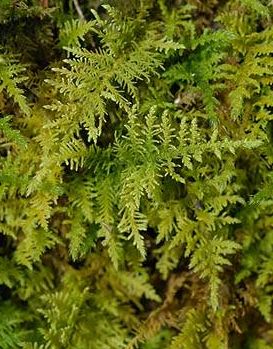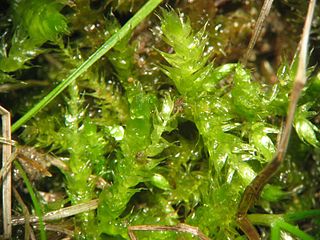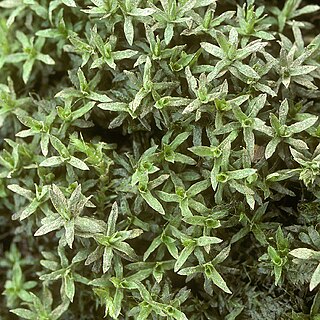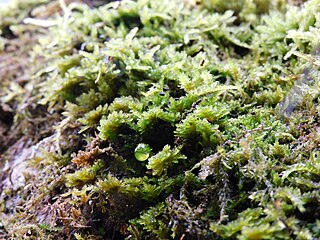
The Bryophyta s.l. are a proposed taxonomic division containing three groups of non-vascular land plants (embryophytes): the liverworts, hornworts and mosses. Bryophyta s.s. consists of the mosses only. They are characteristically limited in size and prefer moist habitats although they can survive in drier environments. The bryophytes consist of about 20,000 plant species. Bryophytes produce enclosed reproductive structures, but they do not produce flowers or seeds. They reproduce sexually by spores and asexually by fragmentation or the production of gemmae. Though bryophytes were considered a paraphyletic group in recent years, almost all of the most recent phylogenetic evidence supports the monophyly of this group, as originally classified by Wilhelm Schimper in 1879. The term bryophyte comes from Ancient Greek βρύον (brúon) 'tree moss, liverwort', and φυτόν (phutón) 'plant'.

Triadenum, known as marsh St. John's worts, is a small genus of flowering plants in the family Hypericaceae. The genus is characterized by opposite, blunt-tipped leaves and pink flowers with 9 stamens. They are distributed in North America and eastern Asia.

Pandanaceae is a family of flowering plants native to the tropics and subtropics of the Old World, from West Africa through the Pacific. It contains 982 known species in five genera, of which the type genus, Pandanus, is the most important, with species like Pandanus amaryllifolius and karuka being important sources of food. The family likely originated during the Late Cretaceous.

Botrypus virginianus, synonym Botrychium virginianum, sometimes called rattlesnake fern is a species of perennial fern in the adders-tongue family. It is monotypic within the genus Botrypus, meaning that it is the only species within the genus. It is called the rattlesnake fern in some parts of North America, due to its habit of growing in places where rattlesnakes are also found. Rattlesnake fern prefers to grow in rich, moist woods in dense shade and will not tolerate direct sunlight.

Hypnales is the botanical name of an order of Bryophyta or leafy mosses. This group is sometimes called feather mosses, referring to their freely branched stems. The order includes more than 40 families and more than 4,000 species, making them the largest order of mosses.

Hypnaceae is a large family of moss with broad worldwide occurrence in the class Bryopsida, subclass Bryidae and order Hypnales. Genera include Hypnum, Phyllodon, and Taxiphyllum.

Zygodon gracilis, the slender yokemoss, is a moss species in the genus Zygodon. It is a rare lithophyte found to only grow on certain localities of limestone outcrops that has high calcium carbonate content. The current global conservation status of Z. gracilis is considered to be "imperiled".

Itatiella ulei is a species of moss in the family Polytrichaceae. It is the only species in the genus Itatiella. The Polytrichaceae is a common family of mosses that does not have close living relatives. Its small size and the inflexed leaf apex characterize Itatiella ulei. When this species grows directly exposed to sun at high elevations, it presents a similar aspect but can be distinguished based on the distal lamella cells which are single and rhombic.

Pogonatum urnigerum is a species of moss in the family Polytrichaceae, commonly called urn haircap. The name comes from "urna" meaning "urn" and "gerere" meaning "to bear" which is believed to be a reference made towards the plant's wide-mouthed capsule. It can be found on gravelly banks or similar habitats and can be identified by the blue tinge to the overall green colour. The stem of this moss is wine red and it has rhizoids that keep the moss anchored to substrates. It is an acrocarpous moss that grows vertically with an archegonium borne at the top of each fertilized female gametophyte shoot which develops an erect sporophyte.

Brachytheciaceae is a family of mosses from the order Hypnales. The family includes over 40 genera and 250 species.

Andreaea rothii, or Roth's andreaea moss, is a species of moss in the family Andreaeaceae native to North America and parts of Europe. This plant was described in 1807 by Weber and Mohr.

Fissidens limbatus commonly known as Herzog's pocket-moss, is a moss in the family Fissidentaceae. This species is found growing in high elevations in tropical America in addition to the US, Mexico and Canada. Montagne first collected F. crispus in 1838.

Buxbaumia viridis, also known as the green shield-moss, is a rare bryophyte found sporadically throughout the northern hemisphere. The gametophyte of this moss is not macroscopically visible; the large, distinct sporophyte of B. viridis is the only identifying structure of this moss. This moss can be found singularly or in small groups on decaying wood, mostly in humid, sub-alpine to alpine Picea abies, Abies alba, or mixed tree forests. This moss is rare and conservation efforts are being made in most countries B. viridis is found in.

Plagiomnium venustum, also known as magnificent leafy moss, is a species of moss belonging to the family Mniaceae. It is found mainly in western North America along the coastal region. This moss can be identified from other members of the Plagiomnium genus by dark coloured stomata guide cells and the absence of sterile stems. It is most commonly found growing as a mat on a variety of substrate, but mainly on humus and moist soil.

Andreaea rupestris is a species of moss in the class Andreaeopsida, are commonly referred to as the "lantern mosses" due to the appearance of their dehisced sporangia. It is typically found on smooth, acidic, exposed rock in the Northern hemisphere. It exhibits the common features of the genus Andreaea such as being acrocarpous, having dark pigmentation, lacking a seta, and bearing 4 lines of dehiscence in its mature sporangia, but can be further identified upon careful examination of its gametophytic leaves which have an ovate base to a more blunt apex compared to other similar species.
Hypnum is a genus of mosses belonging to the family Hypnaceae.
Orthothecium is a genus of mosses belonging to the family Hypnaceae.
Andreaea blyttii, also commonly known as Blytt's rock moss, is a moss belonging to the family Andreaeaceae, commonly known as rock moss, granite moss, or lantern moss because of this family's unique sporangium. It is part of the genus Andreaea which is known for forming dark brownish or reddish-black carpets in high elevations. This species was first described by Schimper in 1855.

Timmia megapolitana, also known as Indian feather moss and warrior moss is a genus of moss in the family Timmiaceae and order Timmiales.

Leptodontaceae is a family of mosses belonging to the order Hypnales. There are 3 genera with a worldwide distribution.
















